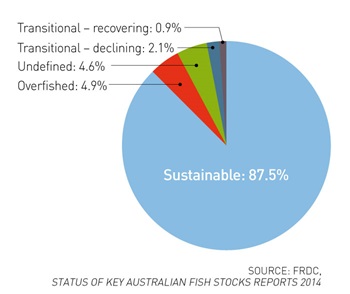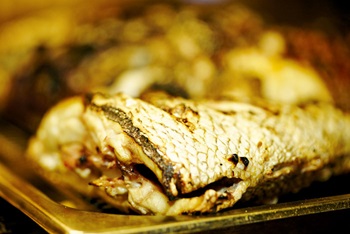The addition of new species further improves reporting on the status of Australia’s fisheries and identifies room for improvement
By Catherine Norwood
 Figure 1 Sustainability of Australian wild-catch fisheries, 2012-13 (by volume).
Figure 1 Sustainability of Australian wild-catch fisheries, 2012-13 (by volume).  FRDC executive director Patrick Hone (left) and Senator Richard Colebeck launching the latestupdate of the Status of Key Australian FishStocks Reports in December 2014.
FRDC executive director Patrick Hone (left) and Senator Richard Colebeck launching the latestupdate of the Status of Key Australian FishStocks Reports in December 2014.The second edition of Status of Key Australian Fish Stocks Reports, released in December 2014, includes 19 new species in addition to the original list of 49 species formally assessed as part of a comprehensive national fisheries reporting system.
The additions mean the reports now encompass 85 per cent of Australia’s wild-catch fisheries by volume, or about 118,700 tonnes of 139,700 tonnes in 2012–13. This represents 90 per cent of the value of Australia’s wild-catch fisheries.
In launching the reports the FRDC’s executive director, Patrick Hone, said the reports reflected well on the status of Australian fisheries overall, although the assessments would provide a wake-up call in some areas. The long-term aim is to ensure that Australian fisheries are synonymous with sustainability, and that management is based on sound science, he said.
‘Sustainability’, as used in the reports, relates to the biological sustainability of a stock – rather than referring to broader ecosystem, economic or social viability. Information is also based on biological fish stocks, rather than management jurisdictions, wherever possible.
Assessment results
Of the 68 species or species groups reported on, there were 238 different assessments of stock undertaken, incorporating single populations assessed in multiple jurisdictions, or multiple populations within a single management jurisdiction.
The results show that 129 fish stocks (87.5 per cent of catch by volume) are being fished sustainably, with seven stocks in recovery.There were 19 stocks in decline and 11 identified as overfished.
‘Overfished’ does not mean a species is in danger, but new management strategies may be required to help the stock recover or, if adequate management is already in place, more time may be required for measures to take effect.
The 11 overfished stocks include Southern Bluefin Tuna (Thunnus maccoyii), of which there is only a single global stock, and Bigeye Tuna (T. obesus), of which there is a single stock within the Pacific Ocean region.
These stocks are fished by many countries, including Australia, and Australia is part of international management efforts to rebuild the populations of these species. Locally specific stocks of School Shark (Galeorhinus galeus), Gemfish (Rexea solandri), two stocks of Greenlip Abalone (Haliotis laevigata), two stocks of Blacklip Abalone (H. rubra), Mulloway (Argyrosomus hololepidotus), Golden Snapper (Lutjanus johnii) and Black Jewfish (Protonibea diacanthus) were also identified as overfished.
Environmental impacts
A new assessment category was introduced to the current report – ‘environmentally limited’. This identifies stocks affected by environmental factors, such as a marine heatwave or disease, rather than by fishing. This applies to two species – Saucer Scallops and Blue Swimmer Crabs (Portunus armatus) (four stocks) impacted by a marine heatwave in Western Australia. There are also 68 stocks for which there are management plans in place, but there is not enough data to provide a confident assessment.


 Photos: Eamon Gallagher
Photos: Eamon GallagherIdentifying problem areas allows fisheries managers and fishers to respond to the issues, and gives consumers and the community confidence in Australian fisheries.
More than 100 leading fisheries researchers have been involved in developing the stock status reports as a scientifically robust, simple tool for fishers, fisheries managers, seafood consumers and the public alike to understand the status of the key wild-capture fish stocks around Australia.
As well as identifying how stocks are travelling, the reports include summaries of how numbers were determined, along with information on catch trends, fishing methods and management. There is information on environmental issues and links to key references for interested people to delve into the science and fisheries.
Future editions are expected to increase the number of species considered and broaden the information provided, although it is unlikely to include all of the 600 species commercially fished (from the 4500 known species) in Australian waters. Later editions may also include formal classifications for broader fishery-level issues such as ecological impacts, economic performance, management performance and social good.
The reports were initiated by the FRDC and the Australian Bureau of Agricultural and Resource Economics and Sciences.
The reports have been produced in collaboration with: government fisheries research agencies in all Australian jurisdictions; the Institute for Marine and Antarctic Studies, Tasmania; the New South Wales Department of Primary Industries; the Department of Fisheries, Western Australia; the Department of Primary Industry and Fisheries, Northern Territory; the Victorian Department of Environment and Primary Industries; the Department of Primary Industries and Regions, South Australia; the South Australian Research and Development Institute; the Queensland Department of Agriculture, Fisheries and Forestry; and CSIRO.
The second edition of the reports represents another step towards greater transparency and consistency of fisheries reporting across Australia.
The reports are available online.
Fish of the day
The launch of the second edition of the Status of Key Australian Fish Stocks Reports was held at Pei Modern restaurant in Melbourne.
The restaurant features fresh seasonal produce, prepared by chef Florent ‘Flo’ Gerardin. Originally from France, he says he began his career filleting hundreds of kilos of fish a day. He has been working in Australia since 2009, initially as sous chef at restaurant Vue De Monde, also in Melbourne, and most recently at Pei Modern.
After arriving in Australia, Flo Gerardin says he quickly stopped trying to adapt European recipes to Australian fish, and focused instead on developing dishes to take advantage of the unique characteristics of the local seafood. At Pei Modern he relies on his fishmonger to bring him the best seasonal catch each day, so the menu changes, depending on what gets delivered.
His menu for the launch included Jack Mackerel tartare with rice cracker as an appetiser, followed by King George Whiting escabeche and Southern Calamari with wasabi leaf salad as entrees. Whole chargrilled snapper, sourced from Port Phillip Bay, provided the main course.
FRDC Research Code: 2014-030





